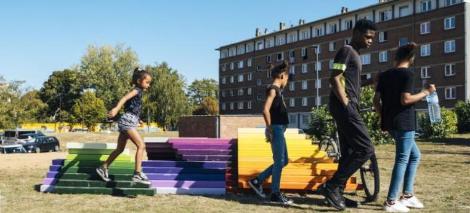The Foresight Factory ‘Nature in priority neighbourhoods
January 2024
Agence nationale de la cohésion des territoires (ANCT)
In September 2022, the Foresight Factory ‘Nature in priority neighbourhoods: what levers for the ecological transition, employment, social cohesion and territorial cohesion?’ proposes to identify and analyse the extent to which the development of nature in priority urban neighbourhoods can provide innovative responses to the challenges facing these neighbourhoods. Over the course of a year, the Fabrique, co-financed by the ANCT and the OFB, worked with 4 intercommunal authorities to co-construct a long-term vision and a programme of actions to be carried out in the short term.
To download : fp_qpv_nature_complet_29_janvier_0.pdf (11 MiB)

Launched in September 2022, the Fabrique Prospective ‘La nature dans les quartiers prioritaires: quels leviers pour la transition écologique, l’emploi, le lien social et la cohésion territoriale? aimed to identify how the development of nature in disadvantaged neighbourhoods could provide innovative responses to the challenges facing these areas. The ANCT commissioned the Ellyx production cooperative (scop) and the Oxalis consultancy firm to run the Fabrique Prospective. In each QPV, the service provider led four local seminars to support the intermunicipal authorities and their partners in a process of reflection that was both forward-looking and operational, focusing on four areas:
-
Boosting the ecological transition of urban neighbourhoods: how to improve the current and future quality of life in urban neighbourhoods thanks to nature, particularly in terms of the quality of life, environmental health and adaptation to climate change (reducing the urban heat island effect in particular)? What practices should be developed to encourage greater attention to, and consideration of, biodiversity in urban neighbourhoods? How can we encourage the deployment of nature-based solutions in disadvantaged neighbourhoods with a view to adapting to the effects of climate change? How can we develop nature areas while anticipating the effects of climate change on their management (availability of water resources, species to be planted, etc.)? How can we use nature in public spaces to encourage people to favour active mobility (walking, cycling, scootering, skateboarding, etc.) over motorised transport?
-
The emergence and development of new nature-based economic activities in disadvantaged neighbourhoods: how can jobs be developed around nature-related activities: upkeep and management of green spaces, gardening, composting, animal husbandry, supervision of nature-based recreational activities, education, awareness-raising, etc.? How can we encourage the development of innovative sectors in the inner city, for example around the concepts of low tech (frugal, easy-to-use technologies that use renewable resources and are therefore based on nature) or biomimicry? How can training or support for retraining in these new nature-based occupations encourage local recruitment of residents from the inner city and the integration of young people and people who have had little or no contact with the labour market?
-
Social cohesion and the participation of local residents in public life: how can we encourage everyone to take ownership of the natural features of their neighbourhood, and thus of their living space? What role should local residents play in the design and implementation of nature-related projects run by EPCIs? How can citizens‘ or associations’ initiatives in favour of nature be better promoted and multiplied? How can we encourage intergenerational and intercultural activities and exchanges between local residents around nature?
-
Strengthening territorial cohesion, i.e. the links between the QPVs and their surrounding areas: how can nature-based infrastructures and activities (ecological corridors, greenways, short circuits, collective workcamps, etc.) promote territorial cohesion on the scale of the conurbation? How can they improve the image of the QPVs, both for their own residents and for those in other neighbourhoods? In addition, how can they make it easier for residents of the QPVs to access the natural, agricultural and forestry areas close to where they live?
The elected representatives of the intercommunal bodies involved in the Fabrique Prospective have each mobilised a working group of around fifteen local players for these seminars: staff and elected representatives from the municipality in which the QPV is located and from its intercommunal body; decentralised government departments; the regional biodiversity agency; local associations; the regional council; the LPO, and so on.
Alternately, four intersite seminars, bringing together representatives of the four inter-municipalities (elected representatives and staff) and the national partners of the Fabrique Prospective (Intercommunalités de France, Ville et Banlieue, DGALN, OFB, Anru, Cerema, USH, RNCRPV, LPO, University of Lausanne) enabled four national courses of action to be co-constructed.
Objectives of the Fabrique Prospective’s local and cross-site seminars ‘Nature in priority neighbourhoods: what levers for the ecological transition, employment, social cohesion and territorial cohesion? July 2022 - July 2023 (Ellyx, Oxalis)
Maps to compare representations of nature in disadvantaged neighbourhoods
One of the aims of the local seminars 1 run by Ellyx and Oxalis was to compare the perceptions that participants in the Fabrique Prospective had of nature in their neighbourhoods. To do this, each participant was asked to locate on a map of the QPV and an aerial map (QPV and surrounding areas):
-
the places and forms of nature in the district (wood, stream, island of trees, wasteland, etc.), - its use(s) (shelter for species, island of coolness, leisure, production, etc.)
-
the people who use it (residents, animals, tourists, professionals, etc.);
-
how it relates to one or more of the themes of the Fabrique Prospective.
This stage enabled the participants to identify their points of convergence and divergence on the place of nature in their neighbourhood, then to build a shared representation and identify the assets, resources and potential of their neighbourhood in terms of nature.